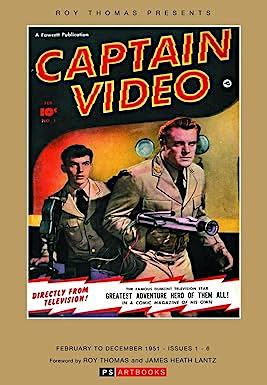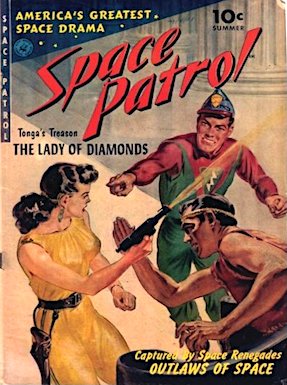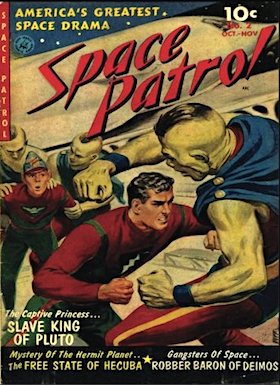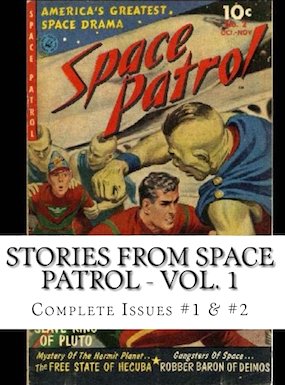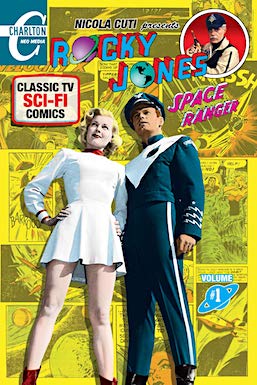Space Cadet
Briefing: Captain Video
More Captain Video
Tom Corbett
More Tom Corbett
Space Patrol
More Space Patrol Space Hero Files
Video Sources
Books & Comics
"I Was There!"
Space Interviews
Space Reports Space Gallery
Space Album
Space Origins
Space Toy Box
Roaring Plastic
Serial Heroes The 1950s
Cosmic Feedback
Colliding Heroes
Space Stamps
Roaring Reviews Space Notice
Space Links <--Retro to
Main Page




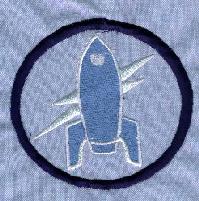

Comics, Books, Videos
| Memories | Video Tape | Books | Comic Books |
|---|


P.O. Box 46161
Phoenix, Arizona 85063 Offers 12 volumes of SPACE PATROL, two shows per tape, $9.95 per tape. Most of the titles as listed are garbled, so it is difficult to tell just what is on each tape. Also has a couple of ROCKY JONES triplet-episodes, like every known public domain video source. (Snore...) Quality rating: B. Return to Top

10917 Winner Road
Independence, MO 64052 Back in the 1970s a collector named Wade Williams acquired the rights to almost all surviving 1950s sf TV kinescopes, and also obtained good prints of most 1950s theatrical sf and fantasy films. His first "1950s space hero" video release, in 1999, was TOM CORBETT, SPACE CADET: THE INVASION FROM MERCURY, 75 minutes for $19.95 plus postage. Check out the web site here and point at Atomic TV. This tape contains only 6 of the first 12 SPACE CADET episodes, so it is quite difficult to follow the story. Here's what is and is not there:
A second release of TOM CORBETT material is also available, under the title "Asteroid of Death." This contains three half-hour programs from NBC (1952), DuMont (1953) and NBC (1954). Two tapes of SPACE PATROL have recently become available from this source, a compilation of the "Amazons of Cydonia" episodes, and a compliation of the "Giants of Pluto 3" episodes, each at about $19.95. Quality rating: A. Return to TopMonday, October 2, 1950. First day at Space Academy for Tom, Astro and Roger. A rocket from Mercury crashes at the Academy Spaceport, killing the Solar Guard officer aboard. [On the tape.]
Wednesday, October 4. Tom sees a mysterious figure crawl from the wreckage. It's a man from a hitherto-unknown race inhabiting the Dark Side of Mercury. The Polaris unit is formed, and Tom and Astro are unhappy to be matched up with the arrogant Roger. [Not on the tape.]
Friday, October 6. Captain Strong briefs the cadets on a mission to Venus. Communication has been lost with the Venus Space Station. Captain Strong (Michael Harvey) forgets all his lines! Roger is appointed senior cadet. [Not on the tape.]
Monday, October 9. The cadets blast off for Venus in the Polaris for the first time, and promptly run afoul of a rogue comet. [On the tape.]
Wednesday, October 11. The Polaris is trapped by Correlli's comet. [Not on the tape.]
Friday, October 13. The Polaris escapes from the comet and continues on to Venus. [On the tape.]
Monday, October 16. First appearance of Edward Bryce as Captain Strong. The cadets arrive on Venus, and find the Space Station deserted. Tom wanders away to investigate a distant light and is captured by a Mercurian. [On the tape.]
Wednesday, October 18. Astro disobeys orders in rescuing Tom and capturing the Mercurian, just as a war fleet from Mercury arrives. [On the tape.]
Friday, October 20; Monday, October 23; Wednesday, October 25. Captain Strong, Tom, Roger, and Astro have various adventures with the Mercurian invaders, ending with Captain Strong and Astro being captured and sentenced to immediate execution! [None of these are on the tape.]
Friday, October 27, last show in the Mercurian sequence. Tom uses a Mercurian radio jammer to jam the chest TV cameras that the light-intolerant Dark-Siders have to use on Venus, thus blinding all the invaders. Captain Strong and the cadets capture the Mercurian invasion leader, and peace is made. [On the tape.]

P.O. Box 87
Toney, AL 35773--0087 When last checked, CAPTAIN BIJOU's on-line catalog listed 8 ROCKY JONES SPACE RANGER compilations, at $12.95 per cassette, the two Englewood SPACE PATROL releases, the two Englewood SPACE CADET releases, two CAPTAIN VIDEO compilations, two CAPTAIN Z-RO compilations, and three cassettes containing two episodes each of the German FLASH GORDON, at prices ranging from $12.95 to $19.95 per cassette. Neither in the on-line catalog nor in the currently rarely-issued printed catalog is there much information about episode titles; for some cassettes there is no information at all. You can also find 11 volumes of the painfully dull Ziv SCIENCE FICTION THEATER, and the 4 volumes of Englewood compilations of TALES OF TOMORROW. The number of vintage TV episodes available from CAPTAIN BIJOU on videocassette has evidently been cut way back currently, compared to printed catalogs from 5 to 10 years ago. In those days, "Captain Bijou" (aka Earl Blair, formerly head of NOSTALGIA MERCHANTS) obtained tapes from a huge variety of sources, and quality could range from A to D. For the old TV show cassettes still available, it seems to range from at least A to C, despite the cutbacks. Return to Top

PO Box 1058
Lewisville, TX 75067 Offers six different SPACE PATROL compilations on video, usually with 4 to 5 half-hour programs per tape, $19.95 each plus postage, $3 for first tape, $1 for each additional. Money orders only. Quality rating: B minus to C. Return to Top


Mike says, "These sites have a nice selection of all our shows!" Return to Tophttp://www.tvideo.com
http://www.moviesunlimited.com
http://www.sinistercinema.com
http://www.hollywoodsattic.com
http://www.cinemaclassics.com
http://www.moviecraft.com

 BEST BOOK ON THE 1950s
SPACE SERIES
No contest, no competition, the best book is THE GREAT
TELEVISION HEROES, by Don Glut and Jim Harmon (Doubleday,
1975). Long out of print, this book is quite easy to find
in the used book market or in large libraries. Chapter 1,
"Zap!", is entirely devoted to Captain Video (8 pages!),
Tom Corbett (6 pages), and Space Patrol (9 pages). Chapter
5 is devoted to the premiums the various programs' sponsors
offered. The information is largely accurate, although the
authors don't take note of the big change that occurred in
Captain Video in 1952-3, when well-known science fiction
authors began to do all the scripts.
THE BOX: AN ORAL HISTORY OF TELEVISION, 1920-1961, by Jeff
Kisseloff (Viking, 1995) has some nice stories about CAPTAIN
VIDEO, including the Captain's unexpected encounter with a
real elephant, and the decision to obtain scripts from
science fiction authors, rather than hacks like Jack
Weinstock and Willie Gilbert, who were writing for almost
every New-York based TV and radio show, from HOWDY DOODY to
SPACE CADET. It contains many wonderful stories about the
unique days of live TV.
CHILDRENS' TELEVISION--THE FIRST THIRTY FIVE YEARS,
1946-1981, by George W. Woolery, is a huge reference book
published in two volumes in 1983, by Scarecrow Press, and
can be found in large libraries. It represents a lot of
research into magazines and newspaper articles of the
1949-59 era, concerning the space hero shows, and the
important shows such as CAPTAIN VIDEO, SPACE CADET and SPACE
PATROL are given long writeups. But there are many careless
misprints, and quite a bit of outright misinformation, which
greatly damage its reliability as a reference. It is fun to
thumb through the book, though, and see how many of the
hundreds of programs listed from 1949-59 you can remember!
SATURDAY MORNING TV, by Gary H. Grossman (Dell, 1981) can
also be found at large libraries and large used book stores.
It has nice photos, and interviews with such notables as
Frankie Thomas and Ed Kemmer, but otherwise it is so
error-riddled as to be virtually worthless. [Roaring
Rockets infallible "researcher" rule: when a book lists a
"researcher" on the title page, in addition to the author,
this means that the author knows ABSOLUTELY NOTHING about
the topics "covered" in the book, and that very little is
gotten right. We have seen dozens of examples of this rule,
with no exceptions known.]
AMERICAN SCIENCE FICTION TELEVISION SERIES OF THE 1950s by
Patrick Lucanio and Gary Colville (McFarland, NC, 1998).
What a strange, lopsided book this is! More than 60 pages
are devoted to "The Adventures of Superman," which is
really not an SF TV series, despite the main character being
from another planet. But, continuing in alphabetical order,
"Atom Squad" gets 1 page (!), "Buck Rogers" gets 1-1/2
pages, "Captain Video" gets 6 pages, "Commando Cody"
gets 6-1/2 pages and a partial episode list, "Flash
Gordon" gets 8 pages with a partial episode list, "Men
Into Space" gets 10 pages with an episode list, "Rocky
Jones, Space Ranger" gets about 11 pages with an episode
list and credits, "Rod Brown of the Rocket Rangers" gets 3
pages with titles of episodes listed, "Space Patrol" gets
about 9 pages with a partial list of the episodes of the
last two seasons only, and "Tom Corbett, Space Cadet,"
gets about 11 pages, with some episodes listed for the
DuMont and NBC runs (two final seasons). There is a bit of
info here and there which I hadn't seen elsewhere, and much
of the info is accurate. Most libraries have these
overpriced McFarland books, which are seemingly made to be
sold only to libraries, rather than individuals with too
much money and too little sense.
THE COMPLETE DIRECTORY TO SCIENCE FICTION, FANTASY AND
HORROR TELEVISION SERIES-- A COMPREHENSIVE GUIDE TO THE
FIRST 50 YEARS, 1946-1996, by Alan Morton (Self published,
1997). This massive paperback has in excess of 980 pages,
and is virtually illegible throughout due to choice of a
reduced typewriter font that looks like "letter gothic."
"Atom Squad" gets 1-1/2 pages with a partial story-arc
list, the only one I've seen. "Buck Rogers" gets 1/2 page
with a partial episode list. "Captain Video" gets 4
pages, with a partial story-arc list. "Flash Gordon" gets
2 pages with an episode list. "Men Into Space" gets 3
pages with an episode list. "Rocky Jones, Space Ranger"
gets 1 page, with a partial episode list. "Rod Brown of
the Rocket Rangers" gets 3 pages with an episode list.
"Space Patrol" gets 11 pages with an episode list. There
are a few things here not seen elsewhere, and much of the
info is accurate. This book is out of print, but can usually be found in libraries. 2nd hand copies can sometimes be found on eBay or Amazon here.
There is now a follow-up volume which presents all of the above info, along with much more:
THE GOLDEN AGE OF TELEFANTASY: A COMPREHENSIVE GUIDE TO SCIENCE FICTION AND HORROR TELEVISION SERIES OF THE 1940s AND 1950s, by Alan Morton (Self published, 2021) In reading through this well-illustrated volume, I continually shook my head in contemplating the vast amount of tireless research that went into it. If you are already an expert in the era, and familiar with many of the programs, you will notice a very few errors, such as misspellings of the names of actors, but these in no significant way affect the accuracy of the discussions of the various series. Since many of these series are essentially lost except for a few individual episodes available on various difficult-to-find DVD collections, or even with no known surviving episodes at all, this book serves an important function in preserving what is known about them, often in surprising detail.
The volume covers not just US series from the late 1940s to about 1960, but also British and Canadian series broadcast during the same time period. Just considering early 1950s space adventure programs, I was there as a kid, aged 10 in 1950, and in those days I was a great fan of CAPTAIN VIDEO (DuMont) and TOM CORBETT, SPACE CADET (CBS, ABC, DuMont and NBC!). But I never got to see more than a few moments of SPACE PATROL, or ROD BROWN OF THE ROCKET RANGERS, and I had never even heard of the syndicated, filmed series ROCKY JONES, SPACE RANGER until about 1980. The discussion of CAPTAIN VIDEO found here is the longest and most detailed I have ever seen anywhere, and illustrated with photos many of which were completely new to me. There are a huge number of rare photos throughout the volume.
I can recommend this book to anyone with any degree of interest in this pioneering era of broadcast TV, when almost all programs were broadcast live, in real time, just as the actors performed the script. To do often stunning special effects under these conditions, as the space adventure series required, was an adventure in itself. They were done live on SPACE PATROL and SPACE CADET, prefilmed on 16 mm on CAPTAIN VIDEO. Here is a time capsule that genuinely returns you to those "thrilling days of yesteryear." I recommend snapping up a copy while they are still available and on sale. It is available on Amazon here or directly from the author. For more information, go here.
BEST BOOK ON THE 1950s
SPACE SERIES
No contest, no competition, the best book is THE GREAT
TELEVISION HEROES, by Don Glut and Jim Harmon (Doubleday,
1975). Long out of print, this book is quite easy to find
in the used book market or in large libraries. Chapter 1,
"Zap!", is entirely devoted to Captain Video (8 pages!),
Tom Corbett (6 pages), and Space Patrol (9 pages). Chapter
5 is devoted to the premiums the various programs' sponsors
offered. The information is largely accurate, although the
authors don't take note of the big change that occurred in
Captain Video in 1952-3, when well-known science fiction
authors began to do all the scripts.
THE BOX: AN ORAL HISTORY OF TELEVISION, 1920-1961, by Jeff
Kisseloff (Viking, 1995) has some nice stories about CAPTAIN
VIDEO, including the Captain's unexpected encounter with a
real elephant, and the decision to obtain scripts from
science fiction authors, rather than hacks like Jack
Weinstock and Willie Gilbert, who were writing for almost
every New-York based TV and radio show, from HOWDY DOODY to
SPACE CADET. It contains many wonderful stories about the
unique days of live TV.
CHILDRENS' TELEVISION--THE FIRST THIRTY FIVE YEARS,
1946-1981, by George W. Woolery, is a huge reference book
published in two volumes in 1983, by Scarecrow Press, and
can be found in large libraries. It represents a lot of
research into magazines and newspaper articles of the
1949-59 era, concerning the space hero shows, and the
important shows such as CAPTAIN VIDEO, SPACE CADET and SPACE
PATROL are given long writeups. But there are many careless
misprints, and quite a bit of outright misinformation, which
greatly damage its reliability as a reference. It is fun to
thumb through the book, though, and see how many of the
hundreds of programs listed from 1949-59 you can remember!
SATURDAY MORNING TV, by Gary H. Grossman (Dell, 1981) can
also be found at large libraries and large used book stores.
It has nice photos, and interviews with such notables as
Frankie Thomas and Ed Kemmer, but otherwise it is so
error-riddled as to be virtually worthless. [Roaring
Rockets infallible "researcher" rule: when a book lists a
"researcher" on the title page, in addition to the author,
this means that the author knows ABSOLUTELY NOTHING about
the topics "covered" in the book, and that very little is
gotten right. We have seen dozens of examples of this rule,
with no exceptions known.]
AMERICAN SCIENCE FICTION TELEVISION SERIES OF THE 1950s by
Patrick Lucanio and Gary Colville (McFarland, NC, 1998).
What a strange, lopsided book this is! More than 60 pages
are devoted to "The Adventures of Superman," which is
really not an SF TV series, despite the main character being
from another planet. But, continuing in alphabetical order,
"Atom Squad" gets 1 page (!), "Buck Rogers" gets 1-1/2
pages, "Captain Video" gets 6 pages, "Commando Cody"
gets 6-1/2 pages and a partial episode list, "Flash
Gordon" gets 8 pages with a partial episode list, "Men
Into Space" gets 10 pages with an episode list, "Rocky
Jones, Space Ranger" gets about 11 pages with an episode
list and credits, "Rod Brown of the Rocket Rangers" gets 3
pages with titles of episodes listed, "Space Patrol" gets
about 9 pages with a partial list of the episodes of the
last two seasons only, and "Tom Corbett, Space Cadet,"
gets about 11 pages, with some episodes listed for the
DuMont and NBC runs (two final seasons). There is a bit of
info here and there which I hadn't seen elsewhere, and much
of the info is accurate. Most libraries have these
overpriced McFarland books, which are seemingly made to be
sold only to libraries, rather than individuals with too
much money and too little sense.
THE COMPLETE DIRECTORY TO SCIENCE FICTION, FANTASY AND
HORROR TELEVISION SERIES-- A COMPREHENSIVE GUIDE TO THE
FIRST 50 YEARS, 1946-1996, by Alan Morton (Self published,
1997). This massive paperback has in excess of 980 pages,
and is virtually illegible throughout due to choice of a
reduced typewriter font that looks like "letter gothic."
"Atom Squad" gets 1-1/2 pages with a partial story-arc
list, the only one I've seen. "Buck Rogers" gets 1/2 page
with a partial episode list. "Captain Video" gets 4
pages, with a partial story-arc list. "Flash Gordon" gets
2 pages with an episode list. "Men Into Space" gets 3
pages with an episode list. "Rocky Jones, Space Ranger"
gets 1 page, with a partial episode list. "Rod Brown of
the Rocket Rangers" gets 3 pages with an episode list.
"Space Patrol" gets 11 pages with an episode list. There
are a few things here not seen elsewhere, and much of the
info is accurate. This book is out of print, but can usually be found in libraries. 2nd hand copies can sometimes be found on eBay or Amazon here.
There is now a follow-up volume which presents all of the above info, along with much more:
THE GOLDEN AGE OF TELEFANTASY: A COMPREHENSIVE GUIDE TO SCIENCE FICTION AND HORROR TELEVISION SERIES OF THE 1940s AND 1950s, by Alan Morton (Self published, 2021) In reading through this well-illustrated volume, I continually shook my head in contemplating the vast amount of tireless research that went into it. If you are already an expert in the era, and familiar with many of the programs, you will notice a very few errors, such as misspellings of the names of actors, but these in no significant way affect the accuracy of the discussions of the various series. Since many of these series are essentially lost except for a few individual episodes available on various difficult-to-find DVD collections, or even with no known surviving episodes at all, this book serves an important function in preserving what is known about them, often in surprising detail.
The volume covers not just US series from the late 1940s to about 1960, but also British and Canadian series broadcast during the same time period. Just considering early 1950s space adventure programs, I was there as a kid, aged 10 in 1950, and in those days I was a great fan of CAPTAIN VIDEO (DuMont) and TOM CORBETT, SPACE CADET (CBS, ABC, DuMont and NBC!). But I never got to see more than a few moments of SPACE PATROL, or ROD BROWN OF THE ROCKET RANGERS, and I had never even heard of the syndicated, filmed series ROCKY JONES, SPACE RANGER until about 1980. The discussion of CAPTAIN VIDEO found here is the longest and most detailed I have ever seen anywhere, and illustrated with photos many of which were completely new to me. There are a huge number of rare photos throughout the volume.
I can recommend this book to anyone with any degree of interest in this pioneering era of broadcast TV, when almost all programs were broadcast live, in real time, just as the actors performed the script. To do often stunning special effects under these conditions, as the space adventure series required, was an adventure in itself. They were done live on SPACE PATROL and SPACE CADET, prefilmed on 16 mm on CAPTAIN VIDEO. Here is a time capsule that genuinely returns you to those "thrilling days of yesteryear." I recommend snapping up a copy while they are still available and on sale. It is available on Amazon here or directly from the author. For more information, go here.
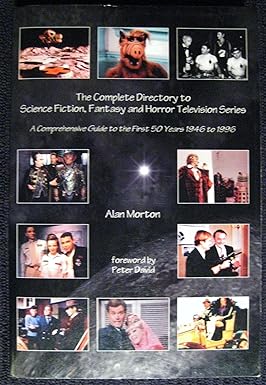
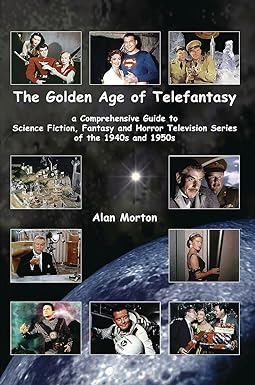
Unfortunately, collecting juvenile series books has become a very popular hobby in recent years, and as always in such a case, predators have appeared. These will gladly sell a beginning collector a "rare" volume for $250, that can be found anywhere for $5. Very common series books, such as the TOM CORBETT and early TOM SWIFT Jr. books, are worth no more than $5-10, without dust jacket, no more than $15 with dust jacket in good condition. It would be a very rare juvenile series book indeed that sold for more than $30, fair price. The last volume in the TOM SWIFT Jr. series is often sold for $300 - 600, but in the past 10 years I have found three different copies at under $5, without setting foot outside the town I live in! So beware. Return to TopA set of juvenile series books featuring TOM CORBETT, SPACE CADET (link1, link2) was published in 1952-56 by Grossett & Dunlap, and the books were clearly best sellers in their day. I have seen few used book stores that don't have a couple of copies. The books were issued in two formats, with dust jackets over a blueish-greenish binding (similar to the color of the Space Cadet uniforms), and without dust jackets, in the so-called "pictorial cover" format. In both formats, the endpapers feature a ripoff of two well-known Chesley Bonestell paintings, and an incredibly poorly drawn version of the Space Cadet emblem of rocket and lightning bolt. The novels are STAND BY FOR MARS (1952), DANGER IN DEEP SPACE, ON THE TRAIL OF THE SPACE PIRATES and THE SPACE PIONEERS (all 1953), THE REVOLT ON VENUS and TREACHERY IN OUTER SPACE (both 1954), SABOTAGE IN SPACE (1955) and THE ROBOT ROCKET (1956). The actual authors of these novels remain a mystery despite a lot of research; the house name "Cary Rockwell" is used for all. A WARNING! Under no circumstances should background information about Tom Corbett, the other space cadets, the Space Academy and the Solar Guard be taken from STAND BY FOR MARS, which "introduces" the Academy and the characters. Whoever the author was, he was clearly provided with almost no background information about the TV series. I have often suspected the author of this volume was British-- the cadets take frequent tea breaks (!) and there is no grasp of "American" conversational dialogue. The (usually uncredited) illustrators also were initially not supplied with reference photos from the TV series. For whatever reason, the first author felt free to make up essentially all the details as he went along, and they are in essentially every case inconsistent with the TV series continuity. However, later novels in the series are not only based fairly closely on actual TV or radio scripts (for instance, ROBOT ROCKET is based partly on "The Space Projectile," broadcast on April 30, 1955), but also seem to be by several different authors, who are much more familiar with the TV series and the personalities of the Polaris unit cadets. Jan Merlin thinks these later novels were written by some of the SPACE CADET TV and radio script writers. All of these books were simultaneously published in England and were quite popular there, although SPACE CADET was never broadcast on TV in England. The British versions of the books had identical text, but different illustrators. It is interesting that the name of the Commander of the Space Academy is different in the novels; since Commander Arkwright was the only character name borrowed directly from SPACE CADET by Robert Heinlein, there were probably legal considerations involved in the change of name in the juvenile novels. There were very, very few juvenile series books in the 1950s with a science-fictional framework, although this period saw the greatest growth in the popularity of science fiction since it was first named as a literary genre in the mid 1920s. Among the few other series:
THE LUCKY STARR series by "Paul French" (Isaac Asimov). DAVID STARR, SPACE RANGER (1952), LUCKY STARR AND THE PIRATES OF THE ASTEROIDS (1953), LUCKY STARR AND THE OCEANS OF VENUS (1954), LUCKY STARR AND THE BIG SUN OF MERCURY (1956), LUCKY STARR AND THE MOONS OF JUPITER (1957) and LUCKY STARR AND THE RINGS OF SATURN (1958) offer Asimov's take on the Space Cadet genre. These may have been Doubleday's only 1950s juvenile series, and they are still readily available in multiple paperback editions-- have a look at any large used paperback store. Asimov is not a writer anyone would associate with the space opera and space action genres, and these novels are far from his best work, but still worth a look.
THE TOM SWIFT JR. series by "Victor Appleton, Jr." takes the son of the orginal 1910s boy inventor, Tom Swift, into the space age. There are 33 books in the series, beginning with TOM SWIFT AND HIS FLYING LAB (1954) and ending with THE GALAXY GHOSTS (1971!). Tom, Jr., moves into space in TOM SWIFT AND HIS ROCKET SHIP in 1954, and soon has a large manned space station, a lunar base, and is battling asteroid pirates! These books, like almost all Stratemeyer Syndicate productions for Grossett and Dunlap, are written by poorly paid ghost writers from banal, repetitive and unimaginative outlines, and deteriorate from poorly written to atrociously written as the series drags on for nearly 20 years, while Tom, Jr. remains a perpetual 18 years old. Early volumes in this series suffered so many reprints that they can be found at nearly every used book store.
THE DIG ALLEN series by Joseph Greene was published by Golden Press in 1959-62. In order, the novels are THE FORGOTTEN STAR, CAPTIVES IN SPACE, JOURNEY TO JUPITER, TRAPPERS OF VENUS, ROBOTS OF SATURN, and LOST CITY OF URANUS. Greene was one of the creators of the SPACE CADET TV series, although as far as I know he never wrote any actually broadcast TV or radios scripts, or any of the juvenile series books. The Dig Allen series gives him a chance to work in the universe he co-created for SPACE CADET, and is well worth a look by fans of SPACE CADET. The books are not as common as the TOM CORBETT volumes, but not that rare either. The books are surprisingly somber and low-key for juvenile SF, with LOST CITY being a real downer, as it involves the mass suicide of an entire alien civilization!
THE MIKE MARS series by Donald A. Wollheim was another Doubleday juvenile sf series, published from 1961 - 64. The titles are MIKE MARS, ASTRONAUT; MIKE MARS FLIES THE X-15; MIKE MARS AT CAPE CANAVERAL; MIKE MARS IN ORBIT; MIKE MARS FLIES THE DYNA-SOAR; MKKE MARS, SOUTH POLE SPACEMAN; MIKE MARS AND THE MYSTERY SATELLITE; and MIKE MARS AROUND THE MOON. As reality caught up with science fiction a bit in the 60s, Wollheim based his characters' exploits on those of actual test pilots and the original Mercury astronauts, but gave them far more risky flights and missions, with a Roger-Manning-like villain, and lots of Russian competition, some of it playing for keeps. Again, volumes of this series are not difficult to find in used book stores.
THE KENT BARSTOW ADVENTURE SERIES by Rutherford G. Montgomery was published by Duell, Sloan and Pearce in 1958-64. The hero is a pilot and secret agent who ventures into space at least twice in the series. Titles are KENT BARSTOW, SPECIAL AGENT; MISSILE AWAY!, MISSION: INTRUDER; KENT BARSTOW, SPACEMAN; KENT BARSTOW AND THE COMMANDO FLIGHT; KENT BARSTOW ABOARD THE DYNA-SOAR, and KENT BARSTOW ON A B-70 MISSION. (The "Dyna-Soar," appearing in both the Mike Mars and Kent Barstow series, was an Air Force-sponsored forerunner of the Space Shuttle.) These books are extremely difficult to find, because Duell, Sloan and Pearce was hardly a prolific publisher.
THE RICK BRANT SCIENCE-ADVENTURE SERIES (link) by "John Blaine" (Harold L. Goodwin) is one of the most popular juvenile series among collectors today, and for that reason is sometimes a challenge to collect. The books were issued by Grossett & Dunlap between 1947-68, in rough parallel with the Tom Swift Jr. series, and provide an refreshing alternative to Tom, namely a "boy inventor" whose inventions are really possible and practical for a teenager. The hero, Rick Brant, has a big advantage in that he lives and works at a private scientific research foundation, Spindrift, directed by his father. While this is not a space adventure series by any means, it had great appeal to science-oriented teenagers, and there was even a non-fiction volume called RICK BRANT'S SCIENCE PROJECTS (1960), which gave hints for science fair entries! There are 23 volumes in the series, beginning with THE ROCKET'S SHADOW and ending with DANGER BELOW! (A 24th volume based on a rejected manuscript was privately printed in 1989, as THE MAGIC TALISMAN, bringing the complete series to 24 volumes.) The books are well-written and well-plotted, except for the last four, and feature many exotic locales, obviously described from first-hand knowledge. Goodwin also wrote a one-shot juvenile space adventure, RIP FOSTER RIDES THE GREY PLANET, for Whitman, under another pen name.
THE WINSTON JUVENILE SCIENCE FICTION series published as "Adventures in Science Fiction," in 36 volumes, was about the only science fiction kids could find in junior high school and high school libraries in the early 1950s. The series is best remembered today for its beautiful dust jackets, painted by such greats of sf illustration as Kenneth Fagg, Alex Schomburg, Virgil Finlay, Ed Emshwiller, and the great Mel Hunter (forgotten today but better than Bonestell in many ways!). Many of the novels (too many) were written by Lester del Rey, but there were also novels by Arthur C. Clarke, Jack Vance, Poul Anderson, Chad Oliver, Raymond F. Jones and Donald A. Wollheim. Some of these books formed regular juvenile series within the overall series. For example, del Rey wrote three volumes about a teenager named Jim Stanley, who implausibly is involved in the construction of a manned space station, and expeditions to the moon. These books are considered highly collectable today, but most copies that turn up are ex-library copies. A website devoted to these books is located here.

